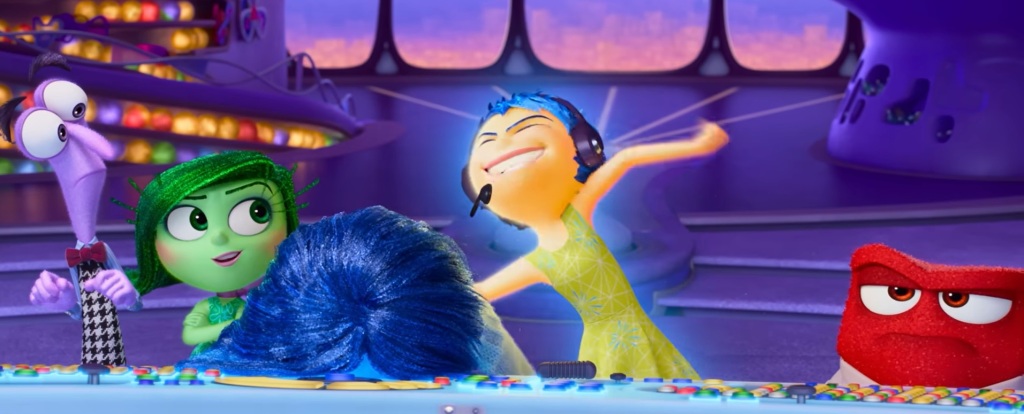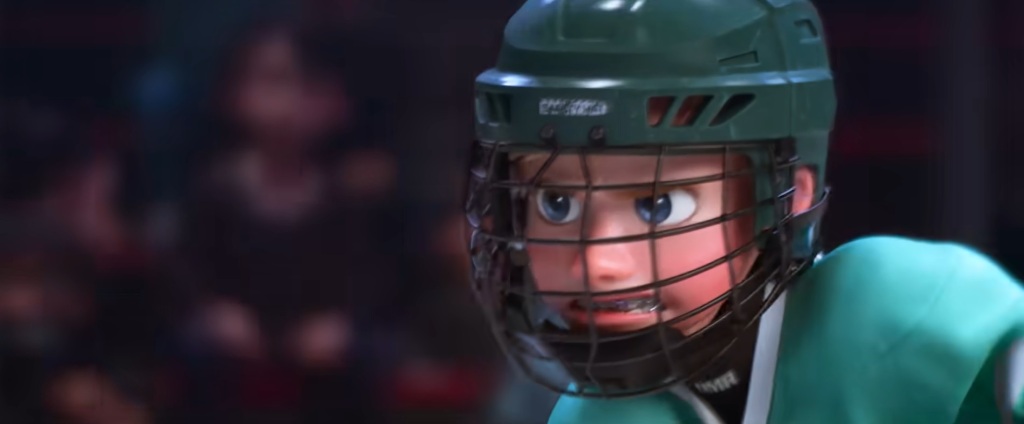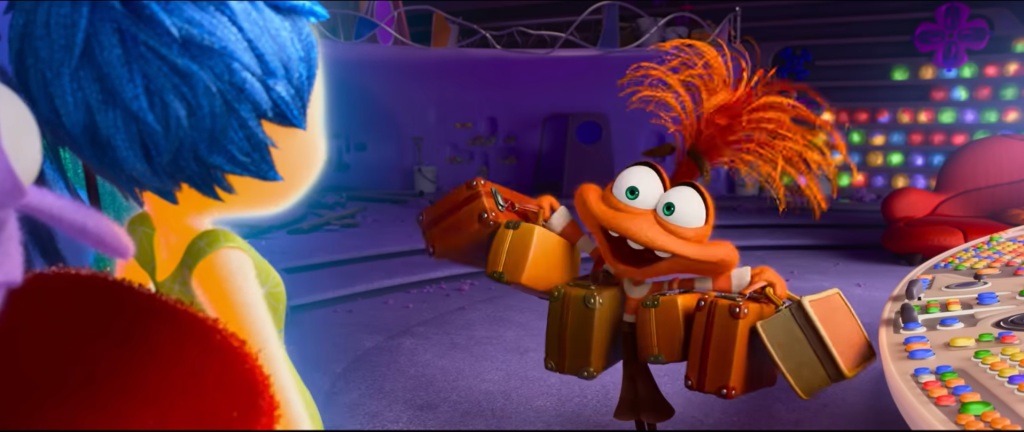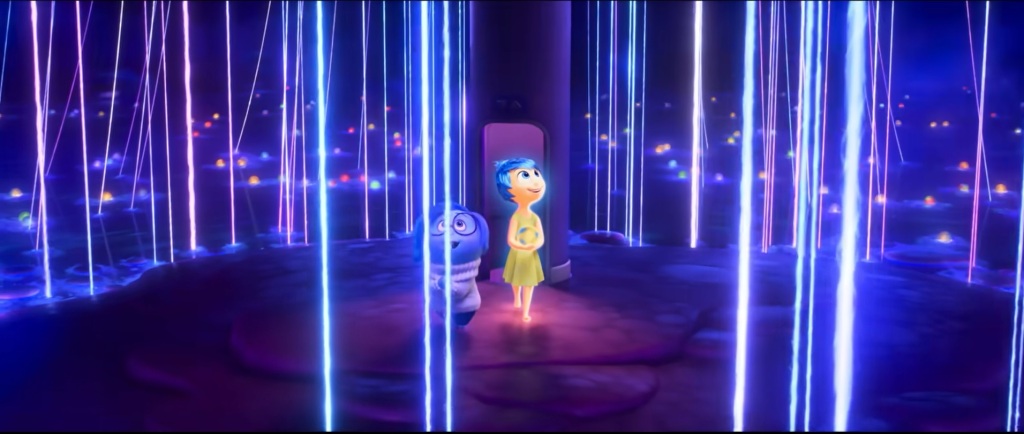Inside Out 2 (Kelsey Mann, 2024): **
If you liked the first Inside Out, which almost everybody did, you’ll enjoy the new one. It creatively brings you inside a stressed adolescent’s mind through animation again. But it’s not the exact same movie. Teenager Riley (Kensington Tallman) endures different turmoil.
Confession: I’m one of the very few with serious complaints about the original. And sadly, I didn’t have a good time with the sequel.

The first Inside Out was about how Riley felt sad when her family moved. Pressuring herself to stay happy, she bottled that sadness up. This decision, however, caused her to suppress joy as well, becoming depressed and numb. That conflict could’ve been too mature for a kid’s film, but Pixar’s animators brought it to life imaginatively and plainly. They rendered Riley’s torn headspace through colorful characters representing her emotions. Those feelings were stationed in a control room symbolizing her head. Golden-bodied, relentlessly optimistic Joy (Amy Poehler) ran the room. Around her: red, short, blocky Anger (Lewis Black), purple, skinny, cowardly Fear (Bill Hader in the last, Tony Hale this time), green, stylish, easily repulsed Disgust (Mindy Kaling last time, Liza Lapira here), and short, stout, blue Sadness (Phyllis Smith).
The story kicked off when Sadness used the room’s panel to express Riley’s pain at leaving her old home, friends, and identity markers. Hoping to keep her happy, Joy struggled with Sadness for the panel, creating chaos in Riley’s mind. As Riley tried to eliminate that chaos by banishing certain feelings, Joy and Sadness were sucked out of the control room, leaving Riley depressed and empty, with just Fear, Anger, and Disgust to express herself.
All this was smart, sophisticated, and sharp, especially for a children’s tale. Too much so.

Have you ever been depressed? Did you ever feel so numb and empty you retreated from the world? Then you know the sensation is not neat and organized. But Inside Out’s metaphors and world-building presented it that way. The film so perfectly matched Riley’s mind’s design with her experience of numbness that it made the vortex that is depression too clean and structured.
You could always tell how some outside event or self-made choice worsened Riley’s loneliness and pain because the movie showed you her mental landscape change immediately; when she cut herself off from core parts of her identity, you saw internal islands shaped around these personality traits like goofiness, family, friendship, or hockey crumble. So you never got lost and confused by her depression. It always made sense to you, which is not how depression feels. It’s a brutal, disturbing condition that rots you from the inside. It can be hard to realize when you go through it, challenging to understand its causes, and nearly impossible to find solutions. By making Riley’s depression so crystal-clear, Inside Out made it less believable.

Don’t get it twisted! I’m not saying this depiction was inaccurate. There’s been numerous articles, studies, and social media posts about how Inside Out nailed this or that behavioral aspect of depression. That’s all fine from a scientific, psychological, or social standpoint—but it’s not art. Art is not the study, quantification, and communication of a topic. It’s not a research paper. It’s the feeling of an experience. Art and life’s messiness break with what sociologists, psychologists, scientists, or therapists say.
That’s why art, emotions, and their absence fascinate, inspire, and trouble us. They remind us our lives, psyches, and identities undermine how things should be. They leave us with profound questions about who we are, how we relate to the world, and how to live. Those questions may have answers, but we do not turn to art for them. We find those answers, if they exist, in science, psychology, philosophy, politics, ethics, religion, and history. Inside Out belongs more to those categories than it does art or entertainment. It contains answers about depression, how it works, and how to overcome it. But it fails to evoke depression’s agony and suffering, what makes us yearn for those answers.

Inside Out 2 has similar flaws–except for one difference. The emotional state flattened now is anxiety. Anxiety (Maya Hawke) is one of the new emotions added to Riley’s control room at the start of puberty. With Riley graduating, having an opportunity to join the high-school hockey team at a summer camp, and discovering her best friends and fellow teammates Grace (Grace Lu) and Bree (Sumayyah Nuridden-Green) will transfer elsewhere, the orange, frenzy-haired, frantically planning Anxiety takes control of the panel.
You can guess how badly this goes. Riley obsesses about failure and loneliness, abandons her friends to suck up to older hockey players, and then antagonizes her teammates by being selfishly competitive at camp to make the team. In turn, her stress skyrockets, causing Anxiety to run even more wild till she forces Joy, Sadness, Anger, Disgust, and Fear out of the control room.
That you can predict anxiety’s impact on Riley is the problem. It’s unsurprising, yes, but it also removes nervousness, suspense, and heart-pounding tension, the very sensations you associate with anxiety. Like the first Inside Out and depression, every plot point, visual image, and character trait thuddingly conveys how anxiety harms Riley and that Riley’s old emotions need to return. Once again, you never lose track of Riley’s situation or what she needs to defeat it. And so, you never enter the panic she’s in, empathize with her hair-pulling dread and fist-clutching stress, or feel her loss of control. Her anxiety is sterile and clinical.
In turn, the picture’s worldbuilding also grates. Yes, the new emotions, like Envy (Ayo Edibiri), Ennui (Adele Exarchopoulos) and Embarrassment (Paul Walter-Hauser), are adorable. And no doubt, Pixar’s arrangement of Riley’s inner mind remains clever. Clouds shower lightbulbs when Anxiety presses Riley to brainstorm how to make the hockey team, debris floats on a…stream of consciousness to mirror the youngster’s random thoughts, and Avatar-like glowing vines shoot to the sky as stand-ins for her self-beliefs, becoming more dark and orange over time thanks to Anxiety. But these inventive sights, while delightful at first, eventually alienate as they did in the predecessor. They seem like products of a stable, healthy, and well-put-together mind, making it impossible to feel you’re witnessing Riley collapse under anxiety’s toll.

I can hear the obvious objections, the frustrated sentiments, at the tip of many tongues. These are kids movies, dude! They’re not meant to be dark or confusing. If they were, children would check out of them and not learn anything. Supporters of ambitious children’s entertainment always want to credit big swings. At least the art exposes kids to something, gives them useful lessons. Sure, Barbie had flawed messaging, but it taught millions feminism 101 (which I guess has flawed messaging too).
As stated earlier, I don’t think the goal of art is to model phenomena or give answers, so I have no issue crediting the Inside Out films for exposure per se. In fact, this is where I believe art’s value lies. When art creates powerful emotional experiences that wash over and break you, it exposes entrancing mysteries about yourself, existence, and actions; in turn, questions you’ve never asked about identity, reality, and morality erupt. The trouble with the Inside Out films is they don’t expose children or adults to depression and anxiety in a way that does this. They treat these things so lifelessly that they fail to provoke reflection. I’ll go further. I’d argue these two films will ultimately convince you to not ask such vital questions.
That’s because they hide depression and anxiety’s transformative, destructive, and messy power. Both Inside Outs don’t help anyone, child or adult, face these frustrating experiences since they show them as easy to recognize and conquer (Riley beats both in two weekends). As a result, they convince people to not acknowledge depression and anxiety’s unknowability so they can reckon with who they are. The films imply it is a problem if it takes you time to overcome the short-circuiting these conditions cause. They encourage you to not spend more than a moment asking questions about yourself, the world, and living in response. And they increase how broken you’ll feel if you admit to being lost in front of these mysterious experiences.
In contrast to these handy instruction manuals, honest depictions of depression and anxiety submerge people in confusion and fear. They know it is only when children and adults stare at these experiences’ cruelty that they long to live with them, to discover the courage to submit to their profound enigmas. The Inside Out franchise isn’t the cure for depression and anxiety or what makes you desperate for the cure, then, but rather a drug that adds to the restless numbness.

